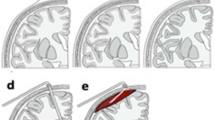Abstract
We want to report on our experiences with the percutaneous trephination using a 2.35 mm round dental drill with serrated saws around it, a “Rosenbohrer”. It is a methodically similar activity as described by J. Zentner [11].
From 1981 to 1992 519 patients were treated and 546 trephinations were performed.
At the beginning this treatment was only used in connection with intracerebral bleedings and biopsies.
In a considerable short time the indication could be extended to the subdural hematoma, tumor cyst, obstructive hydrocephalus as well as to the abscess and the subdural epyema.
The rate of infection was 1.28% and the risk of bleeding 0.36%.
In our opinion the advantages of this small electrical trephination are the easy handling, the universal use and mobility and the avoidable risk of anesthesia as well as the sterilisation at the same time and the stopping of blood, caused by the contact surface friction.
Similar content being viewed by others
References
Bettag W: Über chronische subdurale Hämatome. Act. Neurochir. Wien 5 (1957) 68–81
Burton CH, H Aker: A compact and hand drill for emergency brain decompression. J. Trauma 5 (1965) 643–646
Gilsbach J, J Zentner, A Bernsdorff: Technique, indications and complications of percutaneous needle puncture. Neurochirurgia 31 (1988) 114–117
Hassler W, J Zentner: Ventricle puncture for external CSF drainage and pressure measurement using a modified puncture needle. Acta Neurochir 94 (1988) 93–95
Hubschmann O: Twist drill craniostomy in the treatment of chronic and subacute subdural hematomas in severely ill and elderly patients. Neurosurgery 6 (1980) 233–236
Moringlane J, K v Wild, M Samii: Clinical value of percutaneous needle trephination. Acta Neurochir 54 (1980) 181–189
Moringlane J, M Samii: Beitrag zur operativen Behandlung des chronischen subduralen Haematoms und Hygroms des Erwachsenen. Neurochirurgia 24 (1981) 158–162
Negron R, G Tirado, C Zapater: Simple bedside technique for evacuating chronic subdural hematoma. J Neurosurg 42 (1975) 609–611
Rand B, A Ward, L White: The use of the twist drill to evaluate head trauma. J Neurosurg 25 (1966) 410–415
Tabaddor K, K Shulman: Definitive treatment of chronic subdural hematoma by twist-drill craniotomy and closed-system drainage. J Neurosurg 46 (1977) 220–225
Zentner J, F Duffner, E Behrens: Percutaneous needle trephination for external CSF-Drainage: Experience with 226 procedures. Neurosurg Rev (1995) [in Press]
Author information
Authors and Affiliations
Rights and permissions
About this article
Cite this article
Reiß, G., Andersch, G., Handrick, W. et al. Percutaneous burrhole trephination of the skull: a study of 519 cases. Neurosurg. Rev. 17, 181–184 (1994). https://doi.org/10.1007/BF00418426
Received:
Accepted:
Issue Date:
DOI: https://doi.org/10.1007/BF00418426




